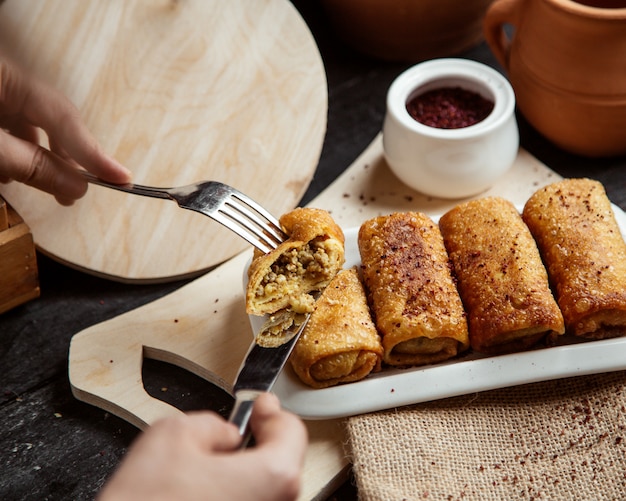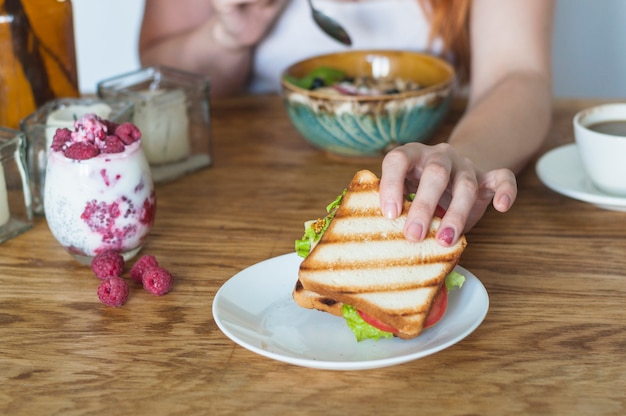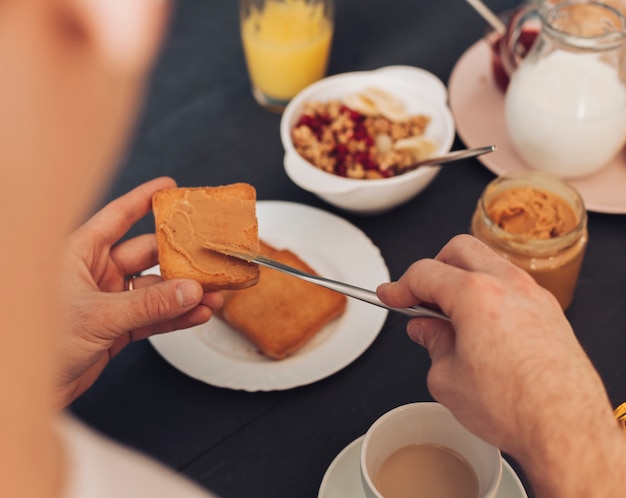Right, let's talk French toast. Now, I know what you're thinking: "French toast? That's just bread soaked in egg and milk, right? How hard can it be?" Well, my friend, you'd be surprised. French toast is one of those dishes that seems simple, but there's a world of difference between a soggy, bland mess and a truly delightful breakfast masterpiece.
Over the years, I've had my fair share of both - the good, the bad, and the downright ugly. But, through trial and error, I've discovered the secrets to making French toast that's not just edible, but absolutely heavenly. So, buckle up, buttercup, because we're about to embark on a culinary adventure to unlock the secrets of this beloved breakfast dish.
(Part 1) The Essentials: Bread, Milk, and Eggs

The Bread: The Foundation of Your French Toast
First things first, let's talk bread. This is the foundation of your French toast, so you want to choose wisely. Forget those flimsy, white sandwich loaves - we're going for something with a little more substance. My personal favourite? Thick-cut challah bread. It's got that beautiful, airy texture that soaks up the custard beautifully, resulting in a rich, fluffy interior.
Think of challah as a sponge for the custard – it absorbs it without becoming mushy, giving you a perfect balance of texture and flavour. It's like a blank canvas ready to be painted with deliciousness.
But challah isn't the only option. Here's a quick rundown of my favourite bread choices:
- Challah: My go-to. It's soft, slightly sweet, and soaks up the custard like a sponge. The slight sweetness of challah complements the richness of the custard perfectly, creating a harmonious flavour profile.
- Brioche: Another classic choice. Similar to challah, but with a slightly richer flavour. Brioche has a denser texture, making it a bit more decadent. If you're looking for a luxurious experience, brioche is your bread.
- Sourdough: For a slightly tangy twist, sourdough works wonders. The tanginess of sourdough cuts through the sweetness of the custard, creating a more complex flavour profile. It's a great option for those who like a bit of an edge to their breakfast.
- French bread: A solid option, but be sure to choose a loaf with a good crust. French bread provides a more rustic flavour and a satisfyingly crispy exterior.
- Texas toast: Thick-cut, buttery toast is great for a hearty French toast. Just make sure it's not too stale. Texas toast is a great choice for a heartier breakfast, as it's dense and satisfying.
Milk: The Secret to Richness
Now, onto the milk. You might think any milk will do, but that's where you're wrong. The right milk can elevate your French toast to a whole new level. My go-to? Whole milk. It's rich and creamy, providing a luxurious flavour that complements the bread perfectly.
Whole milk adds a richness and depth of flavour that you won't find with other types of milk. It coats the bread with a velvety layer, creating a more decadent and satisfying experience.
Eggs: Binding It All Together
Last but not least, the eggs. These are the binding agents that help the bread soak up the milk and create that beautiful, golden crust. Use large eggs for the best results - they're richer and more flavorful.
Eggs are the secret to a cohesive French toast. They act as a glue, holding the bread and custard together and creating a firm texture that won't fall apart. Large eggs are the way to go because they have a higher yolk-to-white ratio, which translates to a richer, more flavorful custard.
(Part 2) The Perfect Custard: Finding the Right Balance

The Art of the Custard: Mixing It Up Right
Now, let's talk about the custard. This is the heart and soul of your French toast, so you want to get it just right. Here's my recipe, and I swear by it:
Ingredients:
4 large eggs
1 cup whole milk
1/4 cup granulated sugar
1 teaspoon vanilla extract
Pinch of salt
Method:
1. In a large bowl, whisk together the eggs, milk, sugar, vanilla extract, and salt until well combined.
The Key to a Perfect Custard: Don't Overmix!
Remember, the key to a perfect custard is to not overmix. You want the mixture to be smooth, but don't whisk it until it's foamy. You're just trying to combine the ingredients evenly. Overmixing can create air bubbles in the custard, which can lead to a lighter, fluffier texture. While that may sound appealing, it can also make the custard less dense and less likely to soak into the bread properly.
(Part 3) Dipping It Right: Achieving Even Soaking

The Dip: Mastering the Technique
Alright, you've got your bread, your custard, and you're ready to dip. But how? You want to ensure even soaking without making your bread soggy.
My Secret Technique:
1. Heat your custard slightly: This helps the bread soak up the custard more quickly and evenly. By gently warming the custard, you're making it more fluid, which helps it penetrate the bread more efficiently. Think of it like a warm bath for the bread – it allows the custard to be absorbed more readily.
2. Dip each slice of bread in the custard for just a few seconds: Don't over-soak. You're looking for a gentle saturation. The goal here is to coat the bread with the custard, not drown it. Oversoaking can lead to a soggy, mushy texture, which is a French toast tragedy.
3. Gently press out any excess custard: This will prevent your French toast from being overly soggy. Excess custard will prevent the bread from developing a crispy exterior and can make it too wet.
(Part 4) The Cook: Bringing it to Life
The Heat: The Final Touch
Now, it's time to cook. I prefer to use a cast iron skillet - it distributes heat evenly and provides a beautiful golden crust.
cooking tips:
Heat the skillet over medium heat: This ensures the French toast cooks evenly without burning. Medium heat allows the French toast to cook through without scorching the outside. It's the sweet spot for achieving a perfectly golden crust.
Add a touch of butter to the skillet: This will create a beautiful golden crust and add a rich flavour. Butter adds a richness and a lovely aroma to the French toast. It's also a great conductor of heat, ensuring that your French toast cooks evenly and develops that beautiful golden hue.
Cook for about 2-3 minutes per side: Flip the French toast when it's golden brown and crispy on the bottom. Keep an eye on your French toast as it cooks. The golden brown colour is a sign that it's ready to flip.
(Part 5) The Finishing Touches: Elevating the Experience
Syrup: The Sweet Embrace
Now, for the grand finale: the syrup. Maple syrup is my personal favourite, but you can use whatever you like. You can even try a homemade syrup for an extra special touch.
Maple syrup is the classic pairing for French toast. Its warm, buttery sweetness complements the richness of the dish perfectly. But don't be afraid to experiment! Try a honey syrup, a pecan syrup, or even a caramel syrup for a more adventurous twist.
Toppings: A Symphony of Flavors
But wait, there's more! French toast is a blank canvas for creativity. Add your favourite toppings to elevate the experience:
- Fresh fruit: Strawberries, blueberries, raspberries - the possibilities are endless. Fresh fruit adds a touch of brightness and acidity to the dish, balancing out the richness of the custard and syrup.
- Whipped cream: A classic topping for a touch of decadence. Whipped cream adds a luxurious touch and a velvety texture to the French toast.
- Nuts: Pecans, almonds, walnuts - a crunchy element that adds texture and flavour. Nuts add a satisfying crunch and a nutty flavour that complements the richness of the dish.
- Powdered sugar: For a simple, sweet finish. Powdered sugar adds a delicate sweetness without overwhelming the other flavours.
- Chocolate sauce: For a decadent twist. Chocolate sauce is the perfect pairing for a rich, indulgent French toast.
(Part 6) Variations: Exploring New Horizons
Savoury French Toast: A Bold Departure
Who says French toast has to be sweet? I love to experiment with savoury variations. Here's a simple recipe I love:
Savoury French Toast Recipe:
Ingredients:
Thick-cut challah bread
4 large eggs
1 cup whole milk
1/4 cup grated Parmesan cheese
1/4 teaspoon salt
1/4 teaspoon black pepper
Olive oil for cooking
Method:
1. In a large bowl, whisk together the eggs, milk, Parmesan cheese, salt, and pepper.
2. Dip the bread slices in the custard mixture.
3. Heat the olive oil in a skillet over medium heat.
4. Cook the French toast for about 3-4 minutes per side, or until golden brown and crispy.
5. Serve with your favourite savoury toppings, such as:
Bacon or sausage
Spinach and feta
Avocado and a drizzle of sriracha
This savoury twist on French toast is perfect for those who are looking for a more substantial and flavorful breakfast. The Parmesan cheese adds a salty, savory depth to the custard, while the olive oil provides a rich and nutty flavour.
French Toast Casserole: A Crowd-Pleasing Delight
For a crowd-pleasing breakfast, try a French toast casserole. It's a great way to use up leftover bread and can be made ahead of time.
French Toast Casserole Recipe:
Ingredients:
1 loaf of challah bread, cubed
6 large eggs
2 cups whole milk
1/2 cup granulated sugar
1 teaspoon vanilla extract
1/4 teaspoon cinnamon
1/4 teaspoon nutmeg
1/4 cup melted butter
Method:
1. Preheat oven to 350°F (175°C).
2. In a large bowl, whisk together the eggs, milk, sugar, vanilla extract, cinnamon, and nutmeg.
3. Add the bread cubes to the custard mixture and stir to coat.
4. Pour the mixture into a greased 9x13 inch baking dish.
5. Drizzle with melted butter.
6. Bake for 40-45 minutes, or until golden brown and set.
This casserole is perfect for a brunch or a family breakfast. It's easy to make ahead of time, so you can spend less time in the kitchen and more time enjoying your company.
(Part 7) French Toast: A culinary journey
A Global Affair: Exploring Regional Variations
French toast, it turns out, isn't just a British or American thing. It's enjoyed all over the world, with each region putting their unique spin on this classic dish.
| Region | Variation | Notes |
|---|---|---|
| France | Pain Perdu | Often served with a rum-based syrup |
| Italy | Torta Fritta | Often filled with ricotta cheese or chocolate |
| Japan | French Toast (フレンチラング) | Often served with maple syrup and whipped cream |
The variations in French toast around the world highlight the dish's versatility. From the rum-soaked Pain Perdu of France to the ricotta-filled Torta Fritta of Italy, each region has its own unique take on this classic dish.
From Humble Beginnings to Culinary Icon
The history of French toast is actually quite interesting. While its exact origins are a bit hazy, it's believed to have emerged in the 14th century as a way to use up stale bread. Over the centuries, it's evolved into the beloved breakfast dish we know and love today, with countless variations and interpretations.
French toast has a long and fascinating history. It started as a simple way to use up leftover bread, but it's evolved into a global culinary icon. The dish has been adapted and transformed over the centuries, reflecting the diverse culinary traditions of the world.
(Part 8) FAQs: Answering Your Burning Questions
1. Can I use stale bread for French toast?
Absolutely! Stale bread actually soaks up the custard more evenly than fresh bread. Just make sure it's not rock hard.
Stale bread is actually ideal for French toast. It absorbs the custard more readily, preventing the French toast from becoming soggy. If you have some leftover bread, don't throw it away! Use it to make a delicious French toast.
2. What if my French toast is too soggy?
If your French toast is too soggy, it's likely that you oversoaked it in the custard. Try gently pressing out any excess custard before cooking. You can also try cooking the French toast for a bit longer to allow the excess moisture to evaporate.
3. How can I make my French toast crispy?
The key to a crispy French toast is to cook it over medium heat in a well-seasoned cast iron skillet. You can also try adding a little bit of cornstarch to the custard mixture. Cornstarch helps to absorb moisture and create a crispy exterior.
4. Can I make French toast ahead of time?
Yes, you can definitely make French toast ahead of time. Simply dip the bread in the custard mixture and refrigerate for up to 24 hours. Then, cook the French toast as usual. This is a great time-saving tip for busy mornings.
5. What are some healthy French toast options?
For a healthier French toast, try using whole-wheat bread or a gluten-free bread alternative. You can also use unsweetened almond milk or coconut milk instead of cow's milk.
These healthy swaps will help you enjoy your favourite breakfast dish without sacrificing your health goals.
Everyone is watching

Prime Rib Roast Cooking Time Chart: Per Pound Guide
Cooking TipsPrime rib roast. Just the name conjures images of lavish dinners, crackling fires, and hearty laughter. It’s ...

How Long to Bake Potatoes in the Oven (Perfect Every Time)
Cooking TipsBaked potatoes are a staple in my kitchen. They're incredibly versatile, delicious, and surprisingly easy to m...

Perfect Rice Every Time: The Ultimate Guide to Cooking Rice
Cooking TipsAs a self-proclaimed foodie, I've always been a bit obsessed with rice. It's the foundation of countless cuisi...

The Ultimate Guide to Cooking Asparagus: Tips, Techniques, and Recipes
Cooking TipsAsparagus. The mere mention of this spring delicacy conjures up images of vibrant green spears, crisp and burs...

Ultimate Guide to Cooking the Perfect Thanksgiving Turkey
Cooking TipsThanksgiving. Just the word conjures up images of overflowing tables laden with delicious food, the scent of r...
